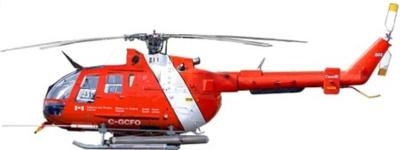Mon, May 24, 2021
AD 2021-10-14 Requires Replacement Of Certain TT-Straps With Serviceable Parts
The FAA is adopting a new airworthiness directive (AD) for certain Airbus Helicopters Deutschland GmbH Model BO-05A, BO-105C, BO-105S, and BO-105LS A-3 helicopters.

This AD was prompted by the FAA's determination that aging of the elastomeric material in a tension torsion strap (TT-strap) could affect the structural characteristics of the TT-strap. This AD requires replacement of certain TT-straps with serviceable parts and implementation of a new storage life limit for TT-straps, as specified in a European Aviation Safety Agency (now European Union Aviation Safety Agency) (EASA) AD, which is incorporated by reference. The FAA is issuing this AD to address the unsafe condition on these products. This AD is effective June 24, 2021.
Supplementary Information: The EASA, which is the Technical Agent for the Member States of the European Union, has issued EASA AD 2019-0024, dated February 4, 2019 (EASA AD 2019-0024) (also referred to as the Mandatory Continuing Airworthiness Information, or the MCAI), to correct an unsafe condition for certain Airbus Helicopters Deutschland GmbH Model BO-105A, BO-105C, BO-105D, BO-105S, and BO-105LS A-3 helicopters. Model BO-105D helicopters are not certificated by the FAA and are not included on the U.S. type certificate data sheet; this AD therefore does not include those helicopters in the applicability.
The FAA issued a notice of proposed rulemaking (NPRM) to amend 14 CFR part 39 by adding an AD that would apply to certain Airbus Helicopters Deutschland GmbH Model BO-105A, BO105C, BO-105S, and BO-105LS A-3 helicopters. The NPRM published in the Federal Register on March 12, 2021 (86 FR 14023). The NPRM was prompted by the FAA's determination that aging of the elastomeric material in a tension TT-strap could affect the structural characteristics of the TTstrap. The NPRM proposed to require replacement of certain TT-straps with serviceable parts and implementation of a new storage life limit for TT-straps, as specified in an EASA AD.
The FAA is issuing this AD to address aging of the elastomeric material in a TT-strap, which could lead to premature failure of a TT-strap, resulting in loss of control of the helicopter. See the MCAI for additional background information.
More News
A Puff Of Smoke Came Out From The Top Of The Engine Cowling Followed By A Total Loss Of Engine Power On May 9, 2025, about 1020 mountain daylight time, an experimental amateur-buil>[...]
From 2022 (YouTube Edition): Jenny, I’ve Got Your Number... Among the magnificent antique aircraft on display at EAA’s AirVenture 2022 was a 1918 Curtiss Jenny painstak>[...]
Very High Frequency (VHF) The frequency band between 30 and 300 MHz. Portions of this band, 108 to 118 MHz, are used for certain NAVAIDs; 118 to 136 MHz are used for civil air/grou>[...]
“From approximately November 2021 through January 2022, Britton-Harr, acting on behalf of AeroVanti, entered into lease-purchase agreements for five Piaggio-manufactured airc>[...]
From 2008 (YouTube Edition): US Fish and Wildlife Service Chooses The Kodiak To Monitor Waterfowl Populations Waterfowl all over North America may soon have to get used to a new ab>[...]
 NTSB Prelim: Lee Aviation LLC JA30 SuperStol
NTSB Prelim: Lee Aviation LLC JA30 SuperStol Classic Aero-TV: Curtiss Jenny Build Wows AirVenture Crowds
Classic Aero-TV: Curtiss Jenny Build Wows AirVenture Crowds ANN's Daily Aero-Term (05.30.25): Very High Frequency (VHF)
ANN's Daily Aero-Term (05.30.25): Very High Frequency (VHF) Aero-News: Quote of the Day (05.30.25)
Aero-News: Quote of the Day (05.30.25) Classic Aero-TV: Quest Kodiak Enhances Migration Monitoring Programs
Classic Aero-TV: Quest Kodiak Enhances Migration Monitoring Programs



